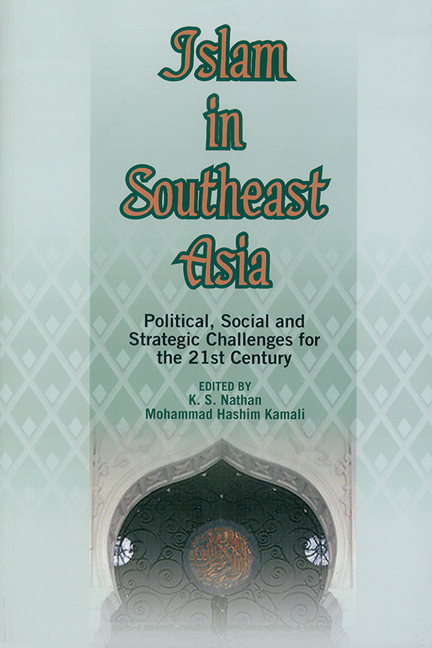Book contents
- Frontmatter
- Contents
- Preface
- Introduction: Understanding Political Islam Post-September 11
- PART ONE ISLAMIC DOCTRINE, HISTORY, GROWTH AND INSTITUTIONS IN SOUTHEAST ASIA
- 1 Islamic Thought: Theory, Concepts, and Doctrines in the Context of Southeast Asian Islam
- 2 The History of Islam in Southeast Asia: Some Questions and Debates
- 3 The Advent and Growth of Islam in the Philippines
- 4 Islamic Economic Institutions in Indonesia: A Religio-Political Perspective
- 5 The Development and Impact of Islamic Economic Institutions: The Malaysian Experience
- PART TWO POLITICS, GOVERNANCE, CIVIL SOCIETY AND GENDER ISSUES IN SOUTHEAST ASIAN ISLAM
- PART THREE MODERNIZATION, GLOBALIZATION AND THE ‘ISLAMIC STATE’ DEBATE IN SOUTHEAST ASIA
- PART FOUR IMPACT OF SEPTEMBER 11 ON ISLAMIC THOUGHT AND PRACTICE
- CONCLUSION: Addressing the Challenge of Political Islam in Southeast Asia
- Note on Contributors
- About the Editors
- Index
3 - The Advent and Growth of Islam in the Philippines
from PART ONE - ISLAMIC DOCTRINE, HISTORY, GROWTH AND INSTITUTIONS IN SOUTHEAST ASIA
Published online by Cambridge University Press: 03 November 2017
- Frontmatter
- Contents
- Preface
- Introduction: Understanding Political Islam Post-September 11
- PART ONE ISLAMIC DOCTRINE, HISTORY, GROWTH AND INSTITUTIONS IN SOUTHEAST ASIA
- 1 Islamic Thought: Theory, Concepts, and Doctrines in the Context of Southeast Asian Islam
- 2 The History of Islam in Southeast Asia: Some Questions and Debates
- 3 The Advent and Growth of Islam in the Philippines
- 4 Islamic Economic Institutions in Indonesia: A Religio-Political Perspective
- 5 The Development and Impact of Islamic Economic Institutions: The Malaysian Experience
- PART TWO POLITICS, GOVERNANCE, CIVIL SOCIETY AND GENDER ISSUES IN SOUTHEAST ASIAN ISLAM
- PART THREE MODERNIZATION, GLOBALIZATION AND THE ‘ISLAMIC STATE’ DEBATE IN SOUTHEAST ASIA
- PART FOUR IMPACT OF SEPTEMBER 11 ON ISLAMIC THOUGHT AND PRACTICE
- CONCLUSION: Addressing the Challenge of Political Islam in Southeast Asia
- Note on Contributors
- About the Editors
- Index
Summary
INTRODUCTION: THE PROCESS OF ISLAMIZATION
The National Geographic Magazine in its September 1980 issue published a map which showed the different countries with significant Muslim populations. A glance at this map reveals that Muslim communities pioneered by the Islamic expansion that began in the seventh century have largely remained and in many cases have grown in spite of political changes inimical to Islam.
The process of Islamization that took place in these countries may vary in detail but certain general patterns can be detected, especially in areas where similar historical circumstances prevailed. In this sense, the Islamization of Southern Philippines cannot be treated as an isolated incident but belongs in its proper context to the Islamic expansion that occurred after the death of the Prophet Muhammad in 632.
This general expansion can be classified into two types of movements. The first was characterized by the military conquests that expanded the Islamic empire out of Arabia to the Middle East, North Africa, Spain, Central Asia and later to Eastern Europe. The second was the expansion of Islam towards Southeast Asia and to Sub-Saharan Africa. This was characterized by the movement of dedicated Muslim individuals either as merchants or as missionaries.
The Islamization of the Malayo-Indonesia archipelago and Southern Philippines belongs to this second movement. Islamization in this phase involved the interplay of many different factors. The first and foremost was the acceleration of trade and the existence of trade routes. One of the oldest trade routes was the Silk Route, an overland connection that linked China to Sumatra and the Middle East over mountains and deserts. Another was an overland caravan route that linked West and North Africa to the Middle East, while still another led to the Volga lands.
The sea routes, which developed later on account of the spice trade started from Malacca on the Malay archipelago across the Indian Ocean and into the Persian Gulf, to Basrah in Iraq and up the Tigris River to Baghdad; or up the mountains of Asia Minor and Armenia to Trebizond on the Black Sea thence to Europe via Constantinople. The Arab market thus extended overland through Central Asia and overseas to Africa, India, China, and Southeast Asia. These routes made possible the tremendous exchange not only of goods but also of people and ideas.
- Type
- Chapter
- Information
- Islam in Southeast AsiaPolitical, Social and Strategic Challenges for the 21st Century, pp. 45 - 63Publisher: ISEAS–Yusof Ishak InstitutePrint publication year: 2005

